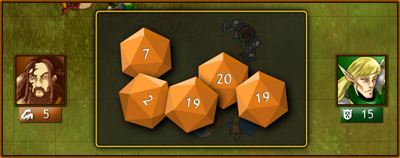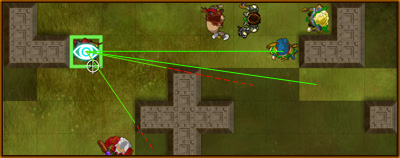
Strategy Tips | Rating System | Rejoining Games | Map Editor | Hot Keys
| Game Mechanics | ||
| Movement |
||
| All units can make one move up to 5 spaces each turn. In order to move, units must have a clear, unobstructed path; they cannot move through other units or walls, and they must move from one adjacent space to the next (diagonal movement is not permitted). | ||
| Sprint | ||
| If a unit does not attack, it can make a second move called “sprint”. At the completion of your move, the Move order icon will transform into the Sprint icon. Issuing this order allows your unit to run an additional 2-7 spaces (determined randomly each time you sprint). If you choose to sprint, your unit will be unable to attack this turn. Units may not sprint two turns in a row. | ||
| Attack | ||
| All units can attack adjacent or diagonal targets. The results of combat are determined by rolling a number of twenty sided dice (D20’s) equal to your unit’s Strength. Any dice result that is equal to or greater than your opponent’s Defense will cause them to lose 1 point of life. When a unit loses all of its life points, it is defeated and removed from the board. | ||
 The Fighter Mage will lose 3 Life because 3 dice beat his Defense of 15. |
||
| Visibility | ||
| Unless stated otherwise, all targets must be visible to the unit using the action. A target is visible if, after drawing an imaginary line from the center of your unit’s space to the center of the target’s space, no walls are intersected. In cases where the line would intersect directly through the corner of a space past a wall, line of sight is not blocked. Use the Line of Sight tool to quickly determine what areas are visible from a given space. | ||
 Lit areas are visible from the highlighted unit. Dark areas cannot be seen. |
||
| The Flow of Magic | ||
| Acting as both a form of energy and as spells, a deck of fifty cards represents the flow of magic in Papillion. Cards start as mana, or pure magical energy. Players generate 3 mana at the start of their turn. Mana can be spent to cast spells with your Mage -or - it can be saved until the end of your turn, at which point, any unused mana is added to your hand as spells.
Cards in your hand are spells. Spells can be cast by your Mage, used to pay for units’ special abilities, or discarded to free room for more cards (since you can only hold a max of seven cards at a time). Cards used to pay for the cost of abilities and spells are returned to the bottom of the deck. Spells remain in play until their effect has worn off and then return to the bottom of the deck. One of the key strategic elements of Hero Mages is deciding how to best use your cards. Will you use them to pay for abilities or will you cast spells? It is also important to consider how your actions will affect your options for the following turn. You might opt to expend all of your mana and available cards during a single turn in order to perform a devastating attack on your opponent. On the other hand, if you spend all of your mana casting spells, you won’t draw any new cards for your next turn, leaving you potentially vulnerable to a counter attack. |
||
| Valor | ||
Hero Mages is designed to reward active and aggressive game participation. As an incentive to emerge from your defensive starting position and engage players in combat, you earn Valor, which activates your Mage’s special abilities. The more you engage and are engaged by enemy players during the game, the greater you put yourself at risk, the more courageous the game considers you to be, and the more you are rewarded for your actions. Players earn:
|
||
| Creatures | ||
| Summon spells allow you to create additional units called “creatures”. Creatures may be placed on any space surrounding your Mage and can move and attack the turn they come into play. With the exception of the Summoner, each mage is only allowed 1 summon spell in play at a time. If you cast a new summon spell while you still have one in play, the old spell is discarded and any creatures it made are removed from the game. Creatures cannot survive in the physical world without heroes. If all of player’s heroes are defeated, any creatures that player controlled are removed from the game. | ||
| Modifiers and Status Effects | ||
| Many spells and abilities within the game alter the statistics of your units, the results of dice, or the cost of spells. For example, you might see verbiage like “Target ally gets Strength +1” or “Target unit gets Defense –4”. When a statistic is positively modified, it will appear in green. When a statistic is negatively modified, it will appear in red. When spells or abilities alter the statistics or status of a unit, they create icons on the unit’s card called “status effects”. You can move over these icons with your mouse cursor to see the details and duration of the effect. Two very important status effects are stun and immobilize. | ||
| Immobilize While immobilized, your unit cannot move. Abilities that say “relocate”, like Teleport and Flash, can still be used. |
||
| Stun While stunned, a unit cannot use any actions until the start of their next turn. Units can be unstunned before their next turn if they are attacked. Note: The attack does not have to cause damage to remove the stun effect. |
||








